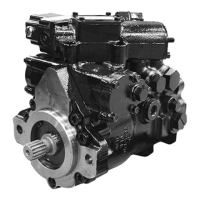Symbols used in Danfoss literature
WARNING may result in injury Tip, helpful suggestion
CAUTION may result in damage to product or
property
Lubricate with hydraulic fluid
Reusable part Apply grease / petroleum jelly
Non-reusable part, use a new part Apply locking compound
Non-removable item Inspect for wear or damage
Option - either part may exist Clean area or part
Superseded - parts are not interchangeable Be careful not to scratch or damage
Measurement required Note correct orientation
Flatness specification Mark orientation for reinstallation
Parallelism specification Torque specification
External hex head Press in - press fit
Internal hex head Pull out with tool – press fit
Torx head Cover splines with installation sleeve
O-ring boss port Pressure measurement/gauge location or
specification
The symbols above appear in the illustrations and text of this manual. They are intended to communicate
helpful information at the point where it is most useful to the reader. In most instances, the appearance
of the symbol itself denotes its meaning. The legend above defines each symbol and explains its purpose.
Design
Danfoss Series 40 M46 closed circuit piston pumps convert input torque into hydraulic power. Rotational
force is transmitted through the input shaft to the cylinder block. The input shaft is supported by
bearings at the front and rear of the pump and is splined into the cylinder block. A lip-seal at the front
end of the pump prevents leakage where the shaft exits the pump housing. The spinning cylinder block
contains seven reciprocating pistons. Each piston has a brass slipper connected at one end by a ball joint.
The slippers are held to the swashplate by a spring washer and charge pressure. The reciprocating
movement of the pistons occurs as the slippers slide against the inclined swashplate during rotation. Via
the valve plate, one half of the cylinder block is connected to low pressure and the other half to high
pressure. As each piston cycles in and out of its bore, fluid is replenished by charge flow and displaced to
the outlet thereby imparting hydraulic power into the system. A small amount of fluid is allowed to flow
from the cylinder block/valve plate and slipper/swashplate interfaces for lubrication and cooling. Excess
flow across the charge pressure relief also flows through the case and is used for cooling. Case drain ports
return this fluid to the reservoir.
The volume of fluid displaced into the system is controlled by the angle of the swashplate. The
swashplate is forced into an inclined position (into stroke) by the servo piston.
The pump control, by varying the pressure at the servo piston, controls the displacement of fluid in the
system circuit.
Service Manual
Series 40 M46 Tandem Variable Pumps
Introduction
6 |
©
Danfoss | September 2017 11029852 | AX00000030en-US0202

